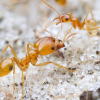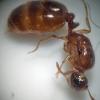- Formiculture.com
- Forums
- Gallery
- Members
- Member Map
- Chat

Brood boosting with different Genera
Started By
TheDrW6
, Oct 29 2022 2:39 PM
9 replies to this topic
#1
 Offline
-
Posted October 29 2022 - 2:39 PM
Offline
-
Posted October 29 2022 - 2:39 PM
So I have a brand new neoponera villosa a queen my friend gave me and a struggling mymrecocystus placodops colony and a larger pseudomyrmex colony. They had a bunch of brood so I gave some of the larvae to the honeypots and the neoponera queen as food but they now took it and are raising the larvae- will they raise them to adulthood?
#2
 Offline
-
Posted October 29 2022 - 3:23 PM
Offline
-
Posted October 29 2022 - 3:23 PM
Brood boosting from another genus almost never works, and the larvae will eventually be eaten. The only exception to this rule is in slave making genera such as polyergus, which are reliant on a host species in order to survive.
My journals:
Polyergus Mexicanus: https://www.formicul...gs/#entry175528
Lasius minutus: https://www.formicul...cs/#entry174811
Lasius latipes: https://www.formicul...gs/#entry206449
General acanthomyops journal: https://www.formicul...yops-with-eggs/
Polyergus Mexicanus: https://www.formicul...gs/#entry175528
Lasius minutus: https://www.formicul...cs/#entry174811
Lasius latipes: https://www.formicul...gs/#entry206449
General acanthomyops journal: https://www.formicul...yops-with-eggs/
#3
 Offline
-
Posted October 30 2022 - 11:53 AM
Offline
-
Posted October 30 2022 - 11:53 AM
Arent they also in different subfamilies?
#4
 Offline
-
Posted October 30 2022 - 12:12 PM
Offline
-
Posted October 30 2022 - 12:12 PM
No. They are both in the same subfamily (Formicinae) and the same tribe (Formicini).Arent they also in different subfamilies?
Sent from my IN2015 using Tapatalk
#5
 Offline
-
Posted October 30 2022 - 12:14 PM
Offline
-
Posted October 30 2022 - 12:14 PM
I’d be interested in running some experiments next year with brood boosting between Veromessor and pogonomyrmex. Specifically P. Cali concolor and Veromessor pergandei.
Ant Keeping Since June 2018
Currently Keeping:
A. versicolor, C. us-ca02, C. yogi, C. Vicinus, C. laevigatus, C. clarithorax, C. maritimus, C. ocreatus, M. mexicanus, M. placodops 01, V. andrei, V. pergandei, N. cockerelli, P. barbata, P. montanus
Hoping to Catch This season:
M. romanei, M. placodops 02, P. imberbiculus, Polyergus sp., F. moki, A. megomatta, Cyphomyrmex sp.,Temnothorax sp.
#6
 Offline
-
Posted October 30 2022 - 1:04 PM
Offline
-
Posted October 30 2022 - 1:04 PM
Brood exchanges only work between closely related species.
- Larvae don't have colony scent, they identify just via the signals they naturally express on their "skin". Foreign larvae are treated like parasites and usually get eaten (often even by the colony's larvae).
- Different genera have different signals (for example if the larva is drying out unrelated ants cannot understand the larva). They probably can't even recognize taht it's hungry even if they manage to identify it as ant larva.
This is also the reason adult ants of different genera will be unable to really form a unified colony, even if they tolerate each other. They simply don't speak the same language.At best you kinda get two colonies that live in the same nest without killing each other. Their interaction will be rudimentary at best.
I've seen people smuggle pupae of Camponotus cruentatus into Colonies of Camponotus barbaricus. This kinda works because both species are very closely related and use pretty much the exact same signals to communicate.
Something most people do not appreciate is just how far apart the different family groups of ants actually are - most of them emerged sometime around the late jurassic/early cretacious period.
Whales and cats are A LOT closer related than for example formicine and myrmicine ants, and even within those families there are some pretty ancient last common ancestors.
Edited by Serafine, October 30 2022 - 1:15 PM.
- aznphenom likes this
We should respect all forms of consciousness. The body is just a vessel, a mere hull.
Welcome to Lazy Tube - My Camponotus Journal
#7
 Offline
-
Posted October 30 2022 - 1:47 PM
Offline
-
Posted October 30 2022 - 1:47 PM
Yeah I’ve found that brood boosting within genus almost always works, including with different subgenus/species groups.
Also the reason slave makers and other social parasites can successfully be brood boosted with different genera is because they are very closely related to their hosts. For example, polyergus is the closest living relative of Formica and is extremely similar genetically, being considered a genus that only recently split off from formica in the evolutionary timeline.
This is called emery’s rule and is a common pattern seen among socially parasitic organisms, not just ants.
Also the reason slave makers and other social parasites can successfully be brood boosted with different genera is because they are very closely related to their hosts. For example, polyergus is the closest living relative of Formica and is extremely similar genetically, being considered a genus that only recently split off from formica in the evolutionary timeline.
This is called emery’s rule and is a common pattern seen among socially parasitic organisms, not just ants.
Edited by Manitobant, October 30 2022 - 1:54 PM.
My journals:
Polyergus Mexicanus: https://www.formicul...gs/#entry175528
Lasius minutus: https://www.formicul...cs/#entry174811
Lasius latipes: https://www.formicul...gs/#entry206449
General acanthomyops journal: https://www.formicul...yops-with-eggs/
Polyergus Mexicanus: https://www.formicul...gs/#entry175528
Lasius minutus: https://www.formicul...cs/#entry174811
Lasius latipes: https://www.formicul...gs/#entry206449
General acanthomyops journal: https://www.formicul...yops-with-eggs/
#8
 Offline
-
Posted October 31 2022 - 6:12 AM
Offline
-
Posted October 31 2022 - 6:12 AM
It's often true but not always.
One exception would be bumblebees where the social parasites are a closed monophyletic group within the genus Bombus, meaning they all come from one single common ancestor despite having vastly different hosts from all across the Bombus genus.
Edited by Serafine, October 31 2022 - 6:12 AM.
- mmcguffi likes this
We should respect all forms of consciousness. The body is just a vessel, a mere hull.
Welcome to Lazy Tube - My Camponotus Journal
#9
 Offline
-
Posted November 1 2022 - 7:26 AM
Offline
-
Posted November 1 2022 - 7:26 AM
I had a small Crematogaster colony with boosted Nylanderia workers a couple years ago.
I've also had:
C. novaeboracensis accept C. chromaiodes
A. lamellidens accept A. fulva
C. lineolata accept C. cerasi
C. chromaiodes accept C. pennsylanicus
H. opacior accept P. pennsylvanica
A. tennesseensis accept A. fula
and a couple other basic ones that I can't remember.
- aznphenom likes this
#10
 Offline
-
Posted November 20 2022 - 12:09 AM
Offline
-
Posted November 20 2022 - 12:09 AM
So, this is probably not the answer you're expecting, and slightly unrelated but it's related enough that I'd like to share my one and only experience with anything similar to this.
So, one day after hunting for queens for LITERALLY HOURS, I was extremely tired and REALLY just wanted to get all the queens I caught (I caught over 200 that day) into their test tubes and put away. It took me almost 2 hours of filling, dumping the queen(s) in, and putting them away. Anyway, two of the species I got that day were solenopsis molesta (thief ants) and brachymyrmex depilis. Both queens of these species, if NOT paying attention fully, can look very similar, especially in dimly lit situations. I, being tired, and half asleep, accidentally put a queen of each species together (both species are extremely polygynous, and I was putting them together in pairs of 2 or 3). I didn't notice for days. Neither have workers YET, but both have a decent brood pile... but guess what the weirdest part is? Not only do the queens not fight, they put their brood pile together... so basically, there's only one pile of brood, mixed with both the molesta and depilis queens' brood. (Yes, I've watched them BOTH lay eggs and add them to the same pile). NOW, thief ants are called this because they actually usually nest in the same nest or area of other species of ants (commonly lasius), and steal their brood. SO, I'm quite unsure how this will go, but I decided to use them as an experiment to see just how they work things out in the spring when they both get workers.
However, to answer your question, I highly doubt brood boosting cross-genera would be viable or even possible. The workers and queen of the colony would most likely ignore or eat the brood added to be a boost.
0 user(s) are reading this topic
0 members, 0 guests, 0 anonymous users


















